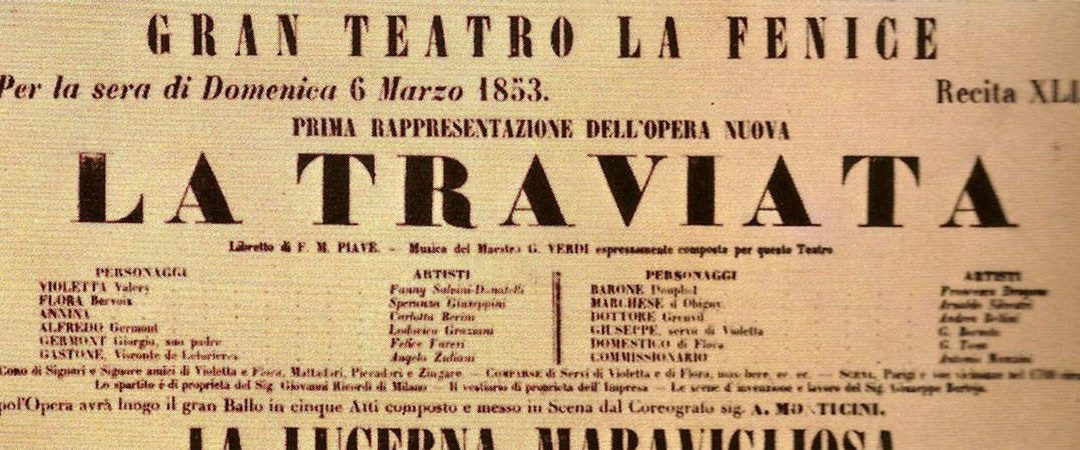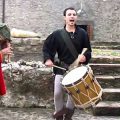Italy is the nation where opera was born. If you love opera and music, at Italian Special Occasions DMC we can help you design bespoke event and travel experiences for families, groups of friends and corporate outings. Imagine the WOW-factor of your family reunion or corporate event in Italy, if you personalize it with an opera theme!
Let’s tune in and find out more about Italy’s famous composers and historic music cities, where our Destination Management Company can organize authentic private tours and special events in historic venues.
GIOACCHINO ROSSINI – MARCHE
Gioachino Antonio Rossini was born in Pesaro (Marche region) on 29 February 1792. His father was a horn player and his mother a singer, so it does not come as a surprise that by the age of six Gioachino was playing the triangle in his father’s musical group! By age 20, Rossini was already writing opere serie (dramas) and opere buffe (comedies) for different theaters, surprising everyone for his fresh and vibrant style.
Rossini is considered as one of the most popular opera composers in history, having written 39 operas as well as sacred music, songs, and some instrumental pieces. His best-known operas include the Italian comedies “Il barbiere di Siviglia” and “La Cenerentola”, and the French-language epics “Moïse et Pharaon” and “Guillaume Tell”.
Among his achievements, Rossini directed Teatro San Carlo in Naples and Théâtre Italien in Paris, and contributed to the creation of the “Grand Opera”, a combination of Italian and French styles based on a historic theme, rich scenic effects, ballet and choirs. He died in 1868 in France, and his body was returned to Italy twenty years later, in the Church of Santa Croce in Florence.
Music and Art in Pesaro
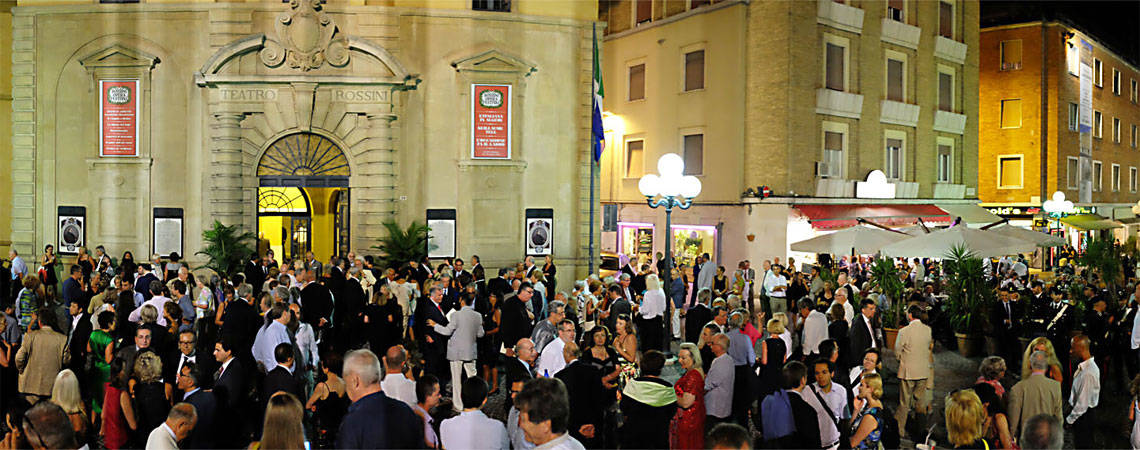
The Festival at Rossini Theater – photo from rossinioperafestival.it
Pesaro is the capital of the Pesaro e Urbino province in the Marche region. The town celebrates its illustrious composer in different ways: it hosts the annual Rossini Opera Festival, and it is home to the State Music Conservatory “Gioachino Rossini”, to the Rossini Theater, and to the Casa Rossini Museum featuring manifestoes, prints, portraits and his spinet.
Pesaro is also an art city for different reasons other than music: the Pesaro Film Festival (Mostra Internazionale del Nuovo Cinema) has taken place here since 1965. If you are a fan of contemporary art, Pesaro offers the Pescheria Center for Visual Arts.
GAETANO DONIZETTI – LOMBARDY
Gaetano Donizetti was born in Bergamo (Lombardy) on 29 November 1797, in a family of humble origins and with no musical background. However, composer Simon Mayr saw the potential and enrolled Gaetano by means of a full scholarship in a music school that he had set up. Mayr also obtained a place for the young man at the Bologna Academy with father Stanislao Mattei, who had been a teacher of Rossini’s.
Donizetti’s first operas were performed in Venice with modest success in 1818. In 1822, he settled in Naples and his career took off with two operas: “Zoraida di Granada” and “La zingara”. He was developing the Bel canto style, writing his hallmark melody lines in a perfect match to Italian lyrics.
Donizetti became famous beyond Italy with his operas “Anna Bolena”, “L’elisir d’amore”, “Lucrezia Borgia” and “Lucia di Lammermoor“. He lived for some time in Paris and then Vienna, where he was given the position of the Court Composer. Over the course of his career, Donizetti wrote about 75 operas, 16 symphonies, 19 string quartets, 193 songs, 45 duets, among others. Unfortunately, he died in Bergamo in 1848 due to a severe illness.
Bergamo’s music legacy
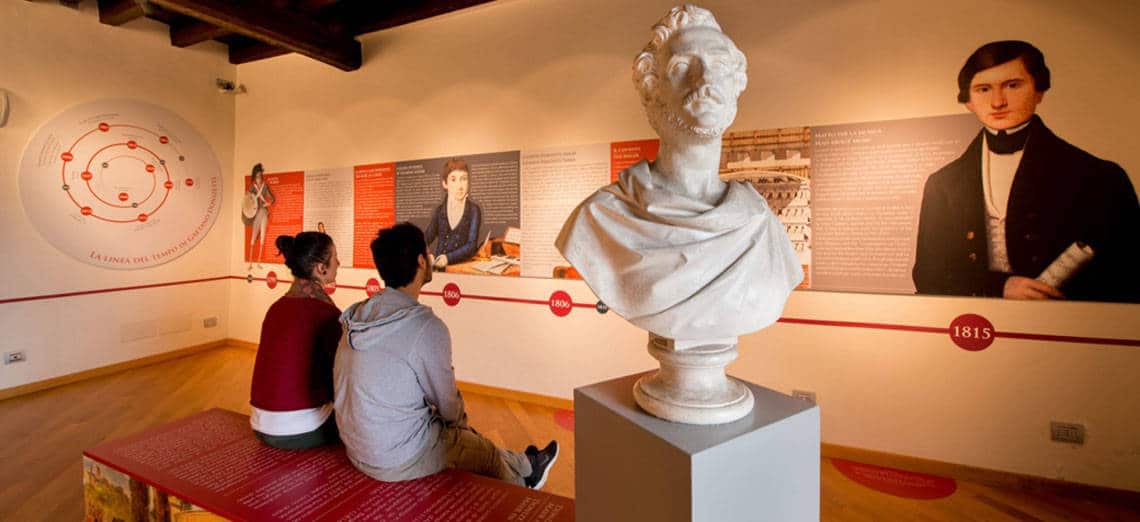
Casa Natale – Donizetti’s birth place house. Photo by Fondazione Donizetti donizetti.org
Bergamo has a prominent place in music history. The tradition of music teaching and singing was kept alive for 800 years in its Romanesque church of Santa Maria Maggiore (built 1137).
Apart from Donizetti, prominent musicians born in Bergamo include Pietro Locatelli, Antonio Lolli and Gianluigi Trovesi. Alessandro Grandi and Tarquinio Merula, some of the most progressive composers of the 17th century, were both maestri di cappella in Bergamo during the 1600s.
Understandably, the city hosts a number of buildings and events dedicated to its illustrious child: the Civic Theater “Gaetano Donizetti”, the Superior Institute for Music Studies (the same Conservatory where Donizetti studied thanks to Mayr), and the Bergamo Musica Festival Gaetano Donizetti.
VINCENZO BELLINI – SICILY
Vincenzo Bellini was born in Catania (Sicily) on 3 November 1801. He started studying music in his Sicilian hometown before moving to Naples in 1819. His first big and unexpected success arrived thanks to “Bianca and Fernando” in 1826, only one year after completing his course. The opera was performed at Teatro San Carlo with the modified name of “Bianca and Gernando” in order not to offend the heir to the throne Ferdinando di Borbone, since no form of his name could be used on a royal stage.
Bellini moved to Milan in 1827, where he obtained enormous successes with “Il Pirata”, “La Straniera”, “La sonnambula”, and “Norma” at La Scala. When he moved to Paris in the early 1830s, he got to meet some of the greatest composers of Europe, such as Fryderyk Chopin. Even though Bellini maintained his usual melodic inspiration intact, his musical language enriched with new colors and solutions. This is quite evident in one of his masterpieces, “I Puritani”, which debuted in Paris at Théâtre de la comédie italienne in 1835.
Unfortunately, the talented composer died when he was just 33 years old because of an intestinal infection. His body remained buried next to Chopin’s in Paris for more than 40 years, before being taken to the Duomo of Catania.
Theaters & Music in Catania
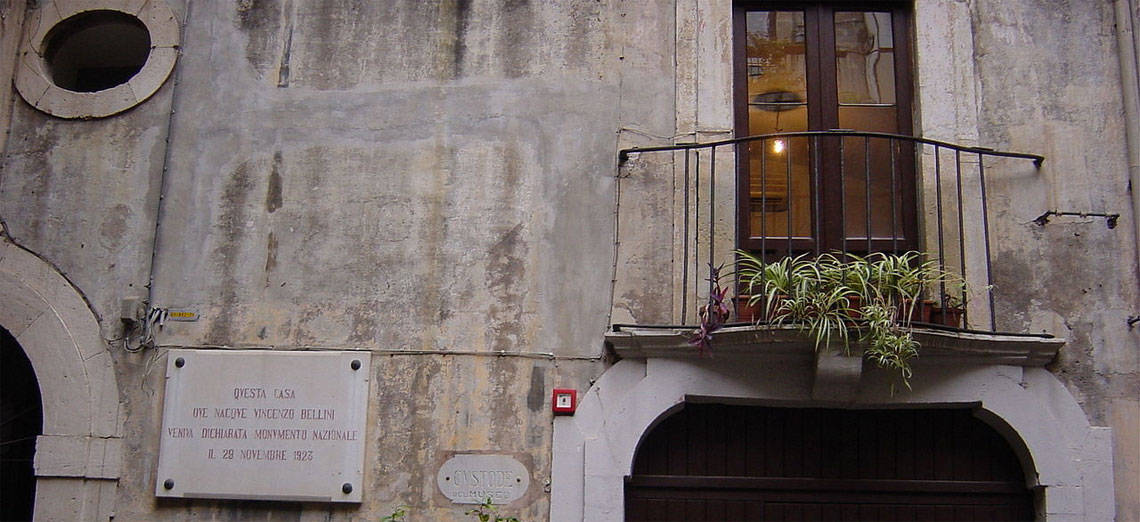
Bellini’s birth place house. Photo by Giovanni Dall’Orto
Catania has two main theaters: Teatro Massimo Bellini, located in the namesake piazza, where the opera season takes place; and Teatro Verga, which hosts the prose season. The former was inaugurated in 1890 with a performance of the composer’s masterwork, Norma. This same opera was performed here by Maria Callas in 1951, to mark the 150th anniversary of the birth of the maestro.
The Sicilian town was also the birthplace of illustrious composers of Art Music (musica colta) in the 1900s: Francesco Paolo Frontini, Alfredo Sangiorgi, Aldo Clementi, Francesco Pennisi, among others.
GIUSEPPE VERDI – EMILIA ROMAGNA
Giuseppe Verdi was born in Roncole di Busseto, in the province of Parma (Emilia Romagna) on 10 October 1813. Verdi’s gift for music was already apparent by 1821, when the 8-year old boy became the official paid organist of the local Church. His musical education developed with the help of a local patron, Antonio Barezzi.
Even though his first pieces of work were not that successful, Verdi obtained an incredible success when he presented “Nabucco” to the Scala di Milano in 1842. The 1840s are a period of hard work for Verdi, who creates twenty operas, including “I Lombardi alla prima crociata”, “Macbeth” and “Luisa Miller”. In 1848, Verdi leaves Milan and moves to Paris, where he obtains even bigger successes with “Rigoletto”, “Trovatore” and “Traviata”.
Verdi eventually returns to Italy with Giuseppina Strepponi, famous Italian operatic soprano who becomes his second wife. They settle in the province of Piacenza. Verdi, whose early operas reflected his sympathy with the Risorgimento movement and the unification of Italy, became a Senator in 1874. He continues creating masterpieces like “La forza del destino”, “Aida”, “Messa da requiem” and – at the incredible age of 80 – “Otello”. He died in Milan in 1901.
Music Tours in Emilia Romagna
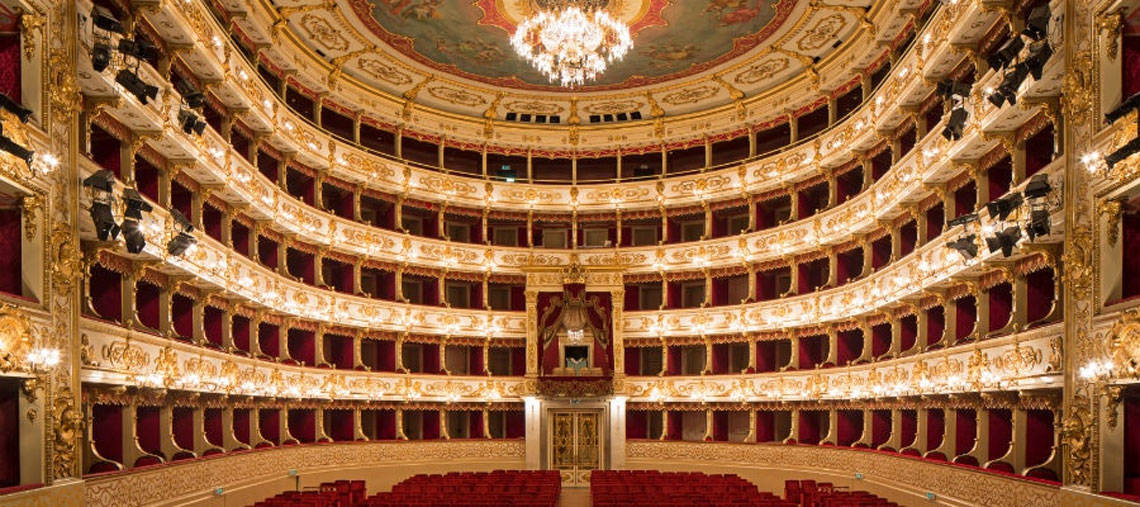
The beautiful Teatro Regio – image from teatroregioparma.it
Giuseppe Verdi was a great character both in the opera world and in the Risorgimento movement for Italy’s unification. You can explore both of these spheres in a series of itineraries in different towns of Emilia Romagna. For example, you can visit his Birth Place House in Roncole in the province of Parma, which is today an innovative multimedia museum that uses technologies like binaural 3D sounds and video mapping.
Other important places are Casa Barezzi, where Verdi got more passionate about music thanks to his patron; and Villa Verdi, surrounded by a luxurious park in a romantic style which was designed by the composer himself in the province of Piacenza.
The musical and political itinerary passes through buildings such as the Verdi Theater in Busseto, the Regio Theater in Parma, and the Risorgimento Museums in both Bologna and Fidenza. Bologna is one of UNESCO’s Creative Cities for Music (for more, read the article Italy’s Creative Cities: Crafts, Design & Music)
GIACOMO PUCCINI – TUSCANY
Giacomo Puccini was born on 22 December 1858 in Lucca (Tuscany) where his family had provided five generations of organists and composers to the Cathedral. However, Giacomo was initially disinterested in music and was generally a poor student. He still managed to become the church organist by age 14. Puccini discovered his true calling in 1876, when he attended a production of Giuseppe Verdi’s “Aida”.
Motivated by his newfound passion, Puccini threw himself into his studies and in 1880 gained admission to the Milan Conservatory. The first successes arrived in 1884 with “La Villi” and in 1893 with “Manon Lescaut”. However, Puccini really made it onto the international scene with three brilliant compositions: “La Bohème” (Turin 1896), “Tosca” (Rome 1900) and “Madama Butterfly” (Milan 1904).
Puccini continued composting during a series of crises in his personal life; but his next works – which included the three-part opera (realistic, tragic and comedic) titled “Il Trittico” – were quickly forgotten. He threw all of his energies into a project called “Turandot”, but his masterwork was completed by Franco Alfano after Puccini was diagnosed with throat cancer and died in 1924.
Lucca’s tributes to Puccini
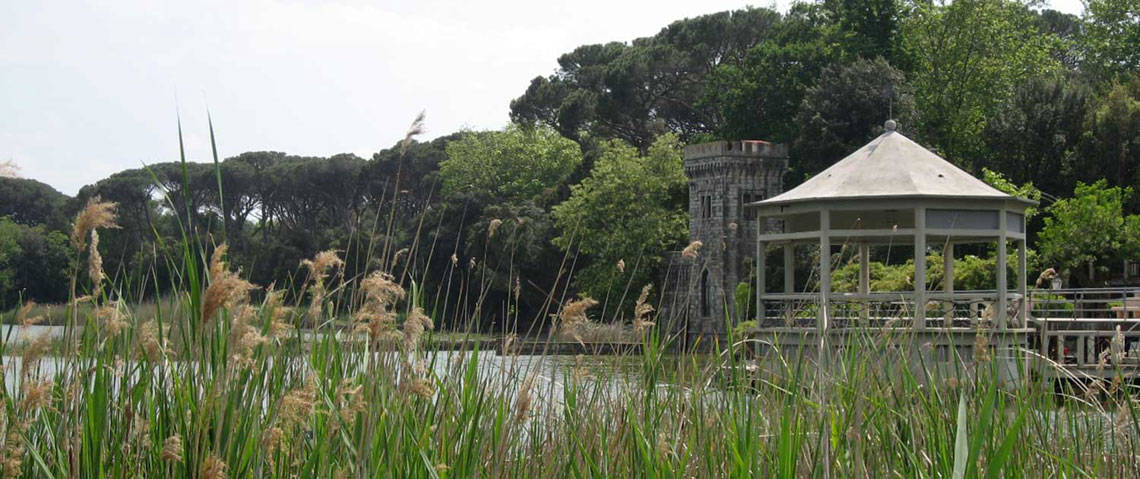
Puccini’s beloved Torre del Lago – photo by puccinifestival.it
Since 2004, Lucca hosts one of the few permanent festivals in the world: “Puccini e la sua Lucca” offers a different program with various performers every single day from 31 March to 31 October, and bi-weekly from 1 November to 30 March. A truly unique way to discover the genius that was Giacomo Puccini!
You can also visit the Museo Casa Puccini, a museum set in the house where the composer was born in 1858 and lived until 1880 with his musical family. The museum treasures the Steinway & Sons piano bought by Puccini in 1901, used for different of his operas and mainly for the composition of Turandot. The instrument was restored in 2006, maintaining its structure and recovering its original sound.
Every year, Festival Puccini attracts around 40,000 attendees. It is held in Torre del Lago, a small town in the province of Lucca. Puccini was buried here, in a small chapel inside a villa he used to own.
Explore Italy’s historic sounds and harmonies with Italian Special Occasions DMC: let us help you design bespoke travel experiences for families, groups of friends and corporate outings.

